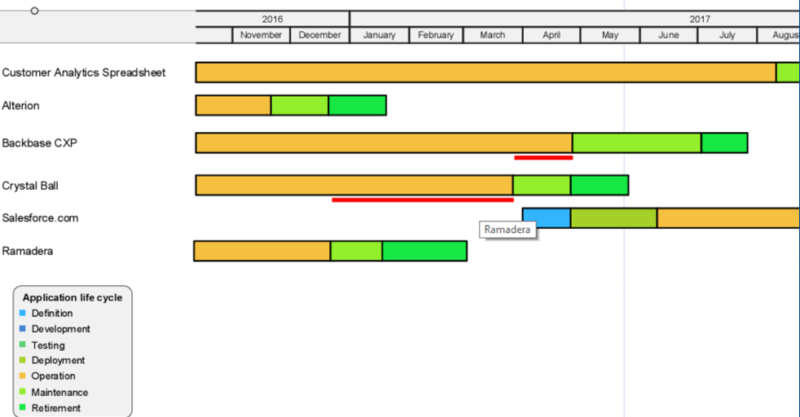Next to this analysis of the enterprise as it is today, addressed in the previous blog posts, we can also plan, design and analyze change in and of the enterprise. To this end, you can give anything in your architecture model a lifecycle. The specific stages in those lifecycles can be defined depending on the types of objects you model. For example, the pre-defined lifecycle for application components comprises the following stages:
In the example architecture used below, we show the lifecycles of some interdependent application components. In the underlying ArchiMate model, the operational stage of the Crystal Ball application depends on the Ramadera application being in operation as well, since in the architecture, Ramadera serves Crystal Ball. Similarly, Backbase CXP depends on Crystal Ball. However, Ramadera is going into maintenance and retirement before Crystal Ball, and Crystal Ball before Backbase CXP. Enterprise Studio automatically detects that there is a conflict between these lifecycles. This is shown with red bars below the lifecycles; hovering over this bar shows the name of the conflicting application with a tooltip.

Lifecycles of some interdependent application components
This works not only for elements of the same type, such as applications; you can also relate different lifecycles, for example to model that an application can only go live after the project developing it has completed and the necessary PaaS service to support it has been contracted.
Download our VIVAT customer story and discover how VIVAT rationalized their application landscape and reduced costs.
Note that this is much more powerful than your regular Gantt charts for project planning. The underlying architecture model contains information on dependencies between the elements of your architecture that cannot be captured in a project planning tool. These dependencies are specific to both the types of relationships and the lifecycle stages you have, making full use of the meaning of these concepts in the ArchiMate modeling language. For example, if one application has a Serving relationship with another (as in the case above), this implies a dependency between their operational stages, but not between, for example, their development stages. These time-based dependencies and lifecycle stages can be fine-tuned to make full use of the analytical capabilities of Enterprise Studio.
These types of analysis are very valuable in planning and optimizing operations and changes in your enterprise. But they don’t tell you much about the importance of these changes. That will be the focus of some of the next blogs in this series. More to follow!